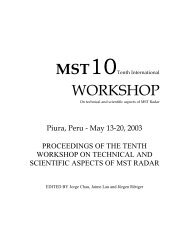vhf atmospheric and meteor radar installation at davis, antarctica
vhf atmospheric and meteor radar installation at davis, antarctica
vhf atmospheric and meteor radar installation at davis, antarctica
- No tags were found...
Create successful ePaper yourself
Turn your PDF publications into a flip-book with our unique Google optimized e-Paper software.
ased upon a geotechnical engineering assessment to protect the array from possible damagedue to permafrost <strong>and</strong> annual freeze <strong>and</strong> thaw cycles. The 3-element Yagi antennas th<strong>at</strong> makeup the array were <strong>at</strong>tached to their vertical 50 mm diameter support posts <strong>at</strong> varying heightsabove the ground so as to set the plane of their driver elements horizontal. The posts ranged inlength from 2 to 4 metres. The posts were supported <strong>at</strong> their base by concrete blocks designedto prevent transl<strong>at</strong>ion <strong>and</strong> rot<strong>at</strong>ion. The strain caused by wind loading on the antennas <strong>and</strong>posts was taken up by a system of guy ropes. Concrete blocks were placed on small pads ofun-reinforced concrete approxim<strong>at</strong>ely 800 mm x 800 mm x 250 mm. These provided an evensurface to support the blocks <strong>and</strong> were oversized to allow the block to be moved into thecorrect position on the pad. The guy system consisted of a network of ropes <strong>at</strong> the height ofthe top of the poles. After tensioning, the guy ropes were secured to anchor points <strong>at</strong> the endsof each row <strong>and</strong> column of antennas. After setting each support post to vertical, the top ofeach post was clamped to an East-West <strong>and</strong> a North-South aligned guy. The rope used was a‘braid’ made of fibre th<strong>at</strong> has a high strength <strong>and</strong> a low stretch factor. The <strong>radar</strong> module haspower <strong>and</strong> fibre optics communic<strong>at</strong>ions to the main st<strong>at</strong>ion network.Radar Oper<strong>at</strong>ing Schedule for the 2003 Austral Winter with Preliminary Observ<strong>at</strong>ionsFigure 2. Horizontal windmeasurements in themesosphere <strong>and</strong> lowerthermosphere obtained withthe VHF <strong>radar</strong> oper<strong>at</strong>ing in<strong>meteor</strong> mode.Through the Antarctic winter, the VHF <strong>radar</strong> schedule emphasises detection of <strong>meteor</strong> echoesfrom the mesosphere <strong>and</strong> lower thermosphere. These echoes are to be used, in conjunctionwith other instruments <strong>at</strong> Davis, for wind <strong>and</strong> temper<strong>at</strong>ure comparisons. However, soundingsof the lower <strong>at</strong>mosphere are carried out every 12 minutes. The frequency <strong>and</strong> dur<strong>at</strong>ion oflower <strong><strong>at</strong>mospheric</strong> soundings was l<strong>at</strong>er increased to every 6 minutes for two hour intervalsfollowing ozone-sonde <strong>and</strong> st<strong>and</strong>ard sonde balloon releases.Figure 3. Direction ofarrival for <strong>meteor</strong>detections on 30 April2003 <strong>at</strong> Davis.
















